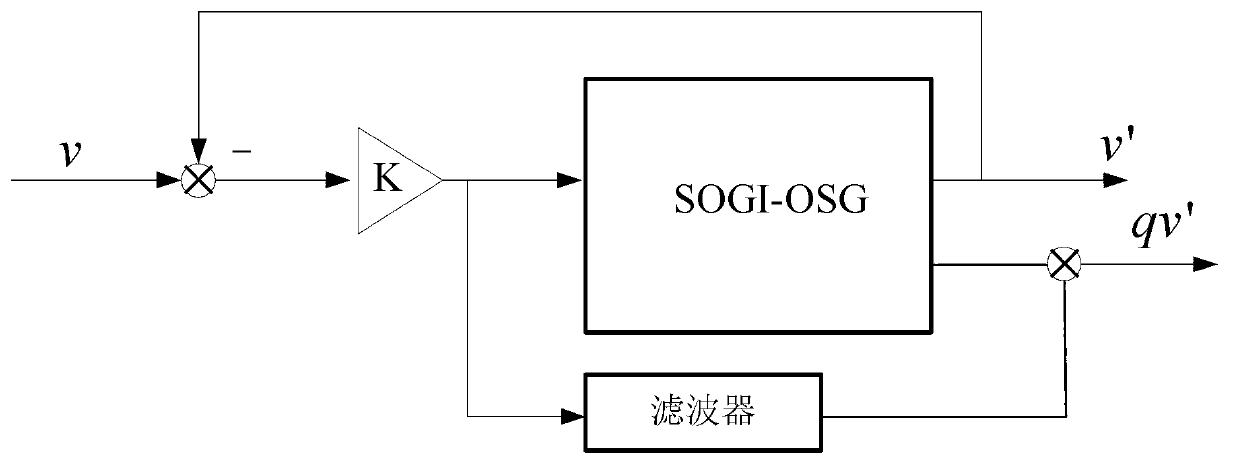Three-phase phase-locked loop method suitable for photovoltaic connected grid low voltage ride-through
A low-voltage ride-through, phase-locked loop technology, applied in the direction of phase angle between voltage and current, measuring electrical variables, measuring devices, etc., can solve the problem that the detection method is not considered, achieve simple feasibility and reduce the cost of grid connection , the effect of eliminating the measurement voltage deviation
- Summary
- Abstract
- Description
- Claims
- Application Information
AI Technical Summary
Problems solved by technology
Method used
Image
Examples
specific Embodiment approach 1
[0022] Specific implementation mode one: see image 3 , Figure 4 with Figure 9 To illustrate this embodiment, the specific process of a three-phase phase-locked loop method suitable for photovoltaic grid-connected low-voltage ride-through described in this embodiment is as follows:
[0023] Step A1: The grid voltage v is input to the second-order quadrature signal generator, and the second-order quadrature signal generator outputs two sinusoidal signals v' and qv' with a phase difference of 90°, and then step A2 and step A3 are performed simultaneously;
[0024] Step A2: Calculate the two sinusoidal signals v' and qv' obtained in step A1 to obtain the line voltage amplitude V RMS , the line voltage amplitude V RMS Converted to phase voltage amplitude V P , and then perform step A4;
[0025] Step A3: Input the two sinusoidal signals v' and qv' obtained in step A1 into the phase-locked loop, and the line voltage phase angle θ l Carry out locking and detection; set the li...
specific Embodiment approach 2
[0028] Specific implementation mode two: see figure 2 Describe this embodiment. This embodiment is a further definition of a three-phase phase-locked loop method suitable for photovoltaic grid-connected low-voltage ride-through described in the first embodiment. The second-order quadrature signal generator is set Second-order quadrature signal generator with low-pass filter.
[0029] The second-order quadrature signal generator described in this real-time mode is an improvement on the existing second-order quadrature signal generator (SOGI-OSG), that is, by adding a low-pass filter to eliminate the influence of voltage offset ,Such as figure 2 shown.
specific Embodiment approach 3
[0030] Specific implementation mode three: see Image 6 Describe this embodiment. This embodiment is a further definition of a three-phase phase-locked loop method suitable for photovoltaic grid-connected low-voltage ride-through described in the first embodiment. The grid voltage v in step A1 is input to The second-order quadrature signal generator, the method of the second-order quadrature signal generator outputting two sinusoidal signals v' and qv' with a phase difference of 90° is:
[0031] After the difference between the grid voltage v and the output signal v' of the second-order quadrature signal generator, the deviation signal ε is obtained. After the deviation signal ε passes through the amplifier, an amplified signal kε is obtained. The amplified signal kε is differenced with the signal qv' to obtain The signal is input to the multiplier, and the multiplier multiplies the signal with the phase-locked angular frequency ω′, and the obtained signal passes through the i...
PUM
 Login to View More
Login to View More Abstract
Description
Claims
Application Information
 Login to View More
Login to View More - R&D
- Intellectual Property
- Life Sciences
- Materials
- Tech Scout
- Unparalleled Data Quality
- Higher Quality Content
- 60% Fewer Hallucinations
Browse by: Latest US Patents, China's latest patents, Technical Efficacy Thesaurus, Application Domain, Technology Topic, Popular Technical Reports.
© 2025 PatSnap. All rights reserved.Legal|Privacy policy|Modern Slavery Act Transparency Statement|Sitemap|About US| Contact US: help@patsnap.com



